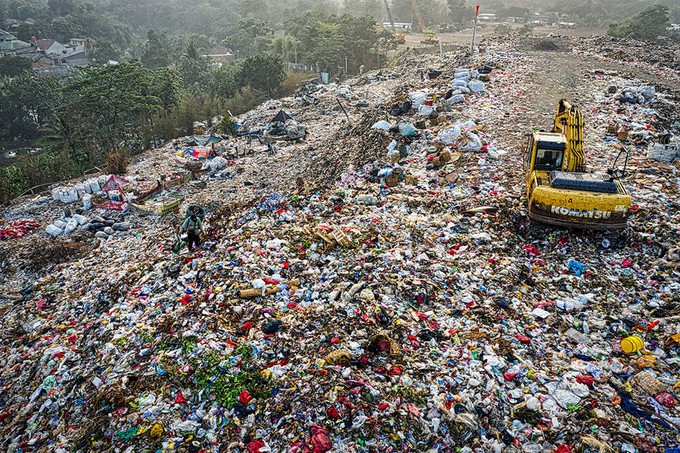- Clothes
- Bags
- Accessories
-
Inspiration
- Shoes
11 Ways to Reduce Your Clothing Waste (& Why It Matters)

Synthetic fabrics taking centuries to decompose. Donated clothes ruining local economies in developing countries. A mountain of discarded garments visible from space (yes, really).
Because of fast fashion, we’re drowning under piles of clothing waste, and the planet can’t take it anymore.
The biggest responsibility should always be on brands. As consumers, though, there’s a lot we can do to help. The best part? It doesn’t have to feel limiting (and this comes from someone who used to love fast fashion).
So, we’ll share 11 things you can do to reduce your clothing waste, but let’s start by why it matters.
Why it’s vital to reduce our clothing waste

Fast fashion brands have trained us to think of clothes as throwaway items, as if they magically disappeared after binning them. Sadly, the reality is much different (and darker).
- Our clothing waste keeps increasing – The average consumer bins 37kg of clothes every year, and we reach 92 million tonnes of textile waste overall… the equivalent of a track full of clothes being incinerated or dumped into landfills every second!
- Discarded clothes keep polluting the planet – Yep, they cause air, soil, and water pollution, especially when they’re synthetic. For example, they shed microplastics, can take 200 years to decompose, and as well as toxic chemicals, they release methane, which contributes to climate change
- It doesn’t justify that garment’s environmental footprint – From the energy required to produce it to the CO2 emissions of its transportation and its end of life, we should wear an item at least 30 times to make up for it. Sadly, we wear them less than 7 before discarding them
- Donating clothes doesn’t really help either – Out of all those donated to charity and thrift shops, only 1 in 5 gets sold, and overall, less than 1% of discarded clothes is recycled into new ones. Everything else? It goes to landfills, gets incinerated, or is sent to developing countries
- They reinforce waste colonialism – Almost half of the clothes sent to developing countries are just waste, and because they’re mostly resold at ridiculously low prices, they hurt local traders and damage their overall economy
Just so we’re clear: brands should do more to reduce clothing waste
Fast fashion and ultra-fast fashion brands, in particular, keep releasing thousands of new throwaway designs every week, without even thinking of their end-of-life. They encourage consumers to keep buying new ones, and they often destroy unsold stock that’s in perfectly good condition. So, they should do better!
A few countries have standard producer responsibility laws covering fashion too, and at the time of writing this article, the EU is working towards one that’d require brands to pay for the collection and recycling of their products
But these regulations aren’t everywhere, and they’re often blurry and hard to enforce.
So, while we keep demanding better from brands, here’s what we can do to reduce our clothing waste.
11 ways to reduce your clothing waste

Some are no-brainers, some might require some time and practice. But once you embrace them? I bet they’ll have a positive impact on both you and your wallet (as well as the planet, of course!).
- Avoid (or reduce) impulse purchases – How about creating a wishlist (for example, “I need one blazer and one patterned top”) and only buying new items accordingly? To remove distractions, you could unsubscribe from the newsletters of fast fashion brands and unfollow influencers promoting overconsumption
- Make the most out of your wardrobe (don’t skip this step!) – The most sustainable clothes are the ones you already own. And before you think “I’m already using my wardrobe” or “I have nothing to wear”, have you actually taken the time to go through it? The chances are, there are plenty of clothes you haven’t worn in ages! And when you try different combinations, it’s like building a new outfit. So, start getting creative with your clothes, remixing them, and embracing repeat outfits, too
- Identify your signature style – When we don’t know what we actually like, it’s easy to get tempted by impersonal micro-trends, buying throwaway clothes that look good but don’t make us feel good
- Keep your clothes for longer – Extending their life by just 9 months will reduce their carbon, water, and waste footprints by 20-30%!
- Help them last longer – Store them tidily so they can “breathe”, instead of cramming them into an overflowing wardrobe. Wash them less (for example, if they’re not dirty, hang them next to an open window or spray them with natural fabric freshener), and when you do wash them, use mesh bags to prevent damage
- Rent for special occasions – Reduce your clothing waste by not buying something you’d only wear once or twice
- Fix your clothes – Don’t give up on them as soon as something goes wrong! Learn to mend them, or take them to your local stitcher
- Upcycle them – Is DIY your thing? Turn old, damaged, and uninspiring items into something new, like upcycling a shirt into a sleeveless top
- Use take-back schemes – Fallen out of love with a garment? Some brands encourage you to send it back so they can resell or recycle it
- Dispose of your clothes sustainably – When you definitely need to get rid of a garment, reduce your clothing waste by selling it online, gifting it to a friend, organising a clothing swap party, or donating it to organisations that are actually going to use it (like local shelters)
- Buy less but better – You could ask yourself: “Do I actually need this? Does it match my style? And will I wear it at least 30 times?”
Choosing ethical clothes makes a huge difference: because they’re made in a way that takes the planet (and workers!) into account, they tend to have a much lower environmental footprint. They’re also made to last and, in some cases, with circularity in mind (for example, by being easy to recycle).
And while ethical clothes tend to be more expensive, investing in fewer high-quality items and rewearing them for years results in a much lower cost-per-wear, which can save you money in the long run (I mean, Shein’s average shopper spends $100 on new clothes every month!).
Struggling to find the right ethical garments? On Project Cece, we brought hundreds of sustainable brands in one place and added filters to simplify your choices!
Fast fashion overconsumption is unsustainable, but there’s so much we can do to reduce our clothing waste.
And as you now know, once you fall in love with fewer clothes that actually feel “you”, you’ll help the planet, save money, and feel happier whenever you rewear them.
Share our story
Related articles
How to Buy Sustainable Clothes: 6 Questions Before a Purchase
It goes beyond finding eco-friendly garments! Here’s how to buy sustainable clothing through 6 questions, from mindset to your wardrobe and how you use it.
Why Repeat Outfits Rock (& How to Wear Them Confidently)
From reducing your carbon emissions to defying sexist expectations, here’s the difference you’ll make by embracing repeat oufits, with 4 tips to get inspired.
How to Take Care of Your Clothes to Make Them Last Longer
Tired of faded or damaged garments? Learning how to take care of your clothes can really make the difference for your wardrobe and wallet as well as the planet. Here’s how!
Project Cece is a platform that collects ethical fashion from vetted brands and shops in one place. Browse ethical fashion for women and men and find items that fit your style, budget and values!
_large.png)


